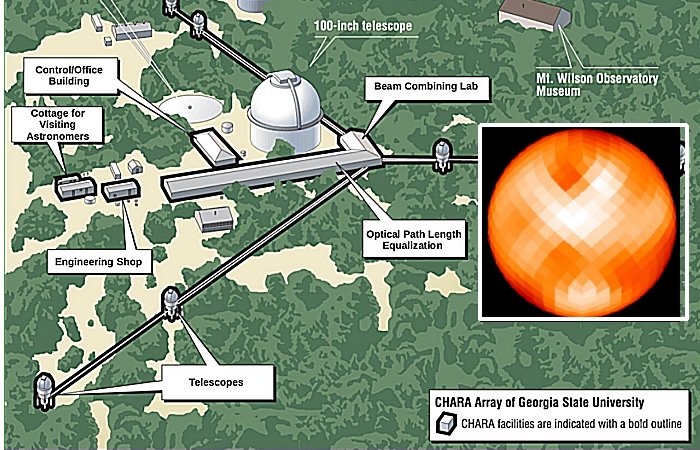Eddie Gonzales Jr. – MessageToEagle.com – Researchers at Georgia State University’s CHARA Array have discovered new details about the North Star’s (Polaris) size and appearance.
Earth’s North Pole points to a direction in space marked by the North Star. Polaris is both a navigation aid and a remarkable star in its own right.
CHARA Array false-color image of Polaris from April 2021 that reveals large bright and dark spots on the surface. Polaris appears about 600,000 times smaller than the Full Moon in the sky.
It is the brightest member of a triple-star system and is a pulsating variable star. Polaris gets brighter and fainter periodically as the star’s diameter grows and shrinks over a four-day cycle.
Polaris is a kind of star known as a Cepheid variable. Astronomers use these stars as “standard candles” because their true brightness depends on their period of pulsation: Brighter stars pulsate slower than fainter stars. How bright a star appears in the sky depends on the star’s true brightness and the distance to the star. Because we know the true brightness of a Cepheid based on its pulsational period, astronomers can use them to measure the distances to their host galaxies and to infer the expansion rate of the universe.
A team of astronomers led by Nancy Evans at the Center for Astrophysics | Harvard & Smithsonian observed Polaris using the CHARA optical interferometric array of six telescopes at Mount Wilson, Calif. The goal of the investigation was to map the orbit of the close, faint companion that orbits Polaris every 30 years.
The CHARA Array is located at the Mount Wilson Observatory in the San Gabriel Mountains of southern California. The six telescopes of the CHARA Array are arranged along three arms. The light from each telescope is transported through vacuum pipes to the central beam combining lab. All the beams converge on the MIRC-X camera in the lab.
“The small separation and large contrast in brightness between the two stars makes it extremely challenging to resolve the binary system during their closest approach,” Evans said in a press release.
The CHARA Array combines the light of six telescopes that are spread across the mountaintop at the historic Mount Wilson Observatory. By combining the light, the CHARA Array acted like a 330-meter telescope to detect the faint companion as it passed close to Polaris. The observations of Polaris were recorded using the MIRC-X camera which was built by astronomers at the University of Michigan and Exeter University in the U.K. The MIRC-X camera has the remarkable ability to capture details of stellar surfaces.
The team successfully tracked the orbit of the close companion and measured changes in the size of the Cepheid as it pulsated. The orbital motion showed that Polaris has a mass five times larger than that of the Sun. The images of Polaris showed that it has a diameter 46 times the size of the Sun.
The biggest surprise was the appearance of Polaris in close-up images. The CHARA observations provided the first glimpse of what the surface of a Cepheid variable looks like.
“The CHARA images revealed large bright and dark spots on the surface of Polaris that changed over time,” said Gail Schaefer, director of the CHARA Array. The presence of spots and the rotation of the star might be linked to a 120-day variation in measured velocity.
“We plan to continue imaging Polaris in the future,” said John Monnier, an astronomy professor at the University of Michigan. “We hope to better understand the mechanism that generates the spots on the surface of Polaris.”
Written by Eddie Gonzales Jr. – MessageToEagle.com Staff Writer

